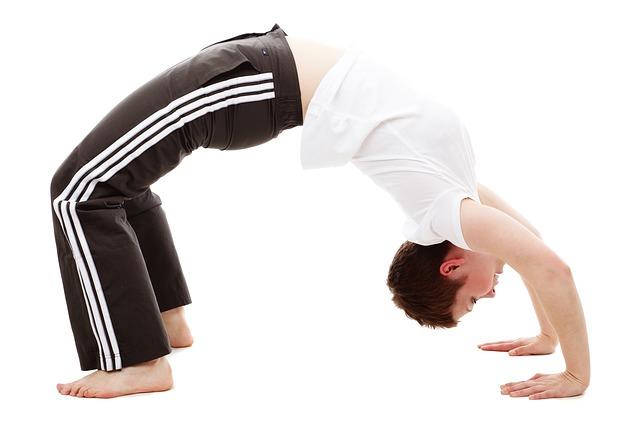Archive for October 2016
Anterior Pelvic Tilt
Anterior pelvic tilt is a rather technical sounding term for a positioning of the body, albeit usually subconscious, that is very common in America. Visual cues that would indicate the presence of anterior pelvic tilt include a forward tilted pelvis, a protruding abdomen, and a pronounced lower back curve. In this position the hip flexors are usually stiff shortened while the hip extensors are lengthened and there is often an accompanying deficiency in abdominal and glute strength.
APT can be problematic for people in the gym: it is especially pronounced with the common exercises of the deadlift and the squat. It is a problem that overlaps with posture and becomes more noticeable and problematic with age: musculoskeletal dysfunction, lower back pain and poor posture are the most common symptoms. At Family Chiropractic & Natural Healing Center, we address APT with an approach that blends postural awareness with strengthening and stretching of all the muscles involved.
- Chiropractic adjustment
- Hip flexor and lower back stretching
- Correcting and teaching posture
- Abdomen and glute strengthening
- Establishing the core as a stabilizer
At our office in the Bay Area, we want to be your partner in overcoming anterior pelvic tilt because we know you will feel a significant difference in well-being and an improvement in pain. This should not be the defining posture of your life, but it is not always easy to conquer the question of posture by yourself. We can lend you a helping hand, but only if you give our office a call to schedule an appointment today.
Dr. Gregory Lind, D.C.
The Question of Flexibility
The question of flexibility is becoming more important as Americans move toward a more sedentary lifestyle. The trend cannot really be helped, as jobs and recreation options are shifted into more screen-oriented settings, but there are steps you can take as an individual to fight the kind of stagnation that occurs to your body during a day spent deskbound. Flexibility, simply defined as the ability of the body to bend without incurring injury, can be added (back) into your life seamlessly, but it does take dedication. The upside to be gained with a more flexible body should be enough to convince you of its worth: being flexible is the best way to eliminate or greatly reduce the chance of back pain. Here are some simple stretches to keep the back flexible:
- Pike stretch: Sit on the floor with legs extended in front of you. Lean forward and try to touch your toes, keeping your back completely straight. Stop before the feeling of resistance turns into pain in any of the main points being stretched: the hamstrings, leg muscles and lower back.
- Pike stretch, standing variant: stand straight up, bend at the waist and reach toward your toes. Bend as far as you can but don’t cause yourself pain. You should feel a stretch in the back and legs.
- Spinal stretch: Lie supine, then cross the right leg over the other while extending the right arm in the opposite direction. You can rest your left hand on the knee of the right leg.
At Family Chiropractic & Natural Healing Center, we believe it is the littlest things which make the biggest difference. We want to help you retain the greatest amount of flexibility as you move forward in life and we can provide you with chiropractic adjustment and help you implement stretching techniques that will truly make a difference in your life.
Dr. Gregory Lind, D.C.
Falling Asleep
Few things influence well-being with quite the same intensity as sleep. But with the constant buzz of technology pulsating at our fingertips, caffeine surging through our bloodstream, various levels of stress palpitating and not enough exercise or proper nutrition to account for it all, it is becoming harder for our society to fall and stay asleep on a regular basis. At Family Chiropractic & Natural Healing Center, we believe that by taking a step back and reassessing habits that may be holding you back, treating your body with the chiropractic care it needs, and paying close attention to environmental stimuli and creating a conducive sleep environment, we can help you get to sleep and stay asleep. Here are some ways to effectively “shut off your brain,” in the lead up to sleep:
- Establish a regular sleep schedule (i.e. aim for a consistent bed time) and establish a pre-sleep routine that involves stretching and maybe even meditation, but certainly a hot cup of soothing sleepy-time tea, or its equivalent in your life.
- Establish the bedroom as a sleep and intimacy chamber and nothing more: keep the television in the living room and food in the kitchen.
- Try relaxing mental exercises and deep breathing: counting sheep is not as silly as it sounds, but try something more complex like mental associations within a single category that keep your mind from stewing over stress.
- Physical activity and other things that release endorphins are great for promoting relaxation and getting your body in a receptive state for sleep.
If you are suffering from pain that is stopping you from sleeping, that is another matter entirely. If this is the case, give our office in the Bay Area a call so we can start addressing your unique pain and getting you on a road to recovery that will help you sleep better and, consequently, feel better every day.
Dr. Gregory Lind, D.C.
Rising and Shining
When it comes to feeling your greatest throughout the day, there are few things that will set you off on the right foot like a good morning stretch routine. Rise and shine often means out of bed and out the door, but if you can find a few minutes upon waking, whether it be pre-shower or post-coffee, your afternoon body and brain will reward you handsomely. Try a few of these simple stretches the next morning you think about it and see how they change your day for the better. Remember that vigorous stretching should be done with a warmed up body, so if you choose to do it straight out of bed, go a little easier.
- Seated spinal twist: sit on a chair with legs together. Rotate from the waist one direction, feeling your spine lengthening. Use one hand on the back of the chair and one hand on the opposite hip to support the stretch. Once you reach a point of resistance, also turn your head to look over your shoulder. Hold for 3 seconds, exhale and repeat on the other side.
- Standing hamstring stretch: stand facing a bench or the bed and put the right leg up onto the bench, keeping it straight with the foot flexed. Keep the standing leg straight and lean forward from the hips, keeping the spine straight. Hold for 5 seconds, repeat with other leg.
- Standing forward bend: Stand with feet at hip width, knees slightly bent, and hinge forward from the hips. In this position, your upper body should hang over the legs. From here, clasp elbows and hold for 3 seconds, then reverse the motion slowly.
All of these stretches are great for the lower back, which is the part of the body that takes the greatest beating during a day at the office. Being proactive about the health of your back is smart- in fact, it’s the greatest investment you can make along with nutrition in order to stay productive and keep a smile on your face. For help on freeing your back from the grips of pain and returning to the greatest life you are capable of leading, give our office in the Bay Area a call and schedule an appointment today.
Dr. Gregory Lind, D.C.
Stretch the Neck
An important stretch for combating the incursions of neck pain during a day of working at the desk is called the levator scapula stretch. The levator scapula is a long muscle that emerges between the 3rd and 4th cervical vertebrae and connects to the shoulder blade. Whenever your neck is stiff or sore, it is worth putting this muscle through some motions to alleviate some of the tension that naturally accumulates throughout the day.
- On the sore side, raise your elbow above the shoulder and rest it against a door jamb. This lengthens the muscle and prepares it for the articulation that will follow and create the stretch.
- Turn your head in the opposite direction of the side that needs stretching and move your chin downward, to create a stretch in the back of the neck.
- Finally, you can use your free hand to pull the head forward gently and add to the intensity of the stretch.
- Hold for as long as possible, but not for more than a minute.
This is one of the most effective stretches for alleviating tension in the neck. Little tricks like this can make the world of difference for chronically stiff and sore spines. If there is a deeper lying problem that may be contributing to your recurrent back pain, give our office a call so we can determine the true cause and help you on a path toward recovery.
Dr. Gregory Lind, D.C.
The Almighty Pelvic Tilt
Everyone has their own unique brand of lower back strain: whether it be none at all, a medium twinge brought on by persistent poor posture or inactivity, or something more severe, there is always something to be done to keep our lower back strong to prevent or ease injury. An anterior pelvic tilt is symptomatic of a posture portfolio that includes rounded shoulders, a protruding abdomen and a head tilted toward the ground (something we call anterior head carriage). This kind of posturing can create unhealthy curvature of the back, and magnify the pressure on the spine, throwing it out of balance and leading to pain and stiffness in the muscles of the back.
- Pelvic tilts are a super stretch which can help negate some of this daily damage, and they can be done just about anywhere (you just want a firm surface below)! Here’s how:
- Lie supine with knees elevated and feet flat on the floor.
- Place your hand in between your lower back and the floor to define the space you will be filling with your stretch then remove your hand.
- Inhale and tilt your pelvis, using your abs until your back lies flush on the floor.
- In this position, your butt should be slightly lifted and you should feel a pull in the muscles of the pelvis and lower back. Hold for five then exhale and return to the starting position.
This constitutes 1 rep, and you should repeat 3 times at least, totaling 15 seconds. Can you afford that once in the morning and once in the evening? If so, you will be doing innumerable good for a back that is wary from the strains of daily life.
Dr. Gregory Lind, D.C.




